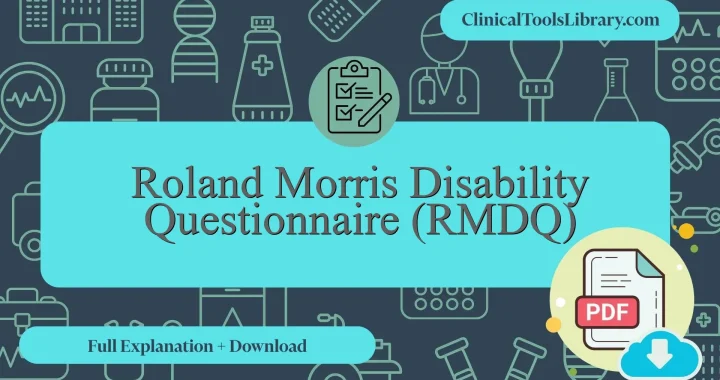In this article, we explain everything you need to know about the Roland Morris Disability Questionnaire (RMDQ). We will cover the aspects it evaluates, the target population, a detailed step-by-step explanation, and how to interpret its results. Additionally, we will dive into the scientific evidence supporting this tool (diagnostic sensitivity and specificity) in clinical assessment. You will also find official and unofficial sources available for download in PDF format.
What does the Roland Morris Disability Questionnaire (RMDQ) assess?
The Roland Morris Disability Questionnaire (RMDQ) is a self-reported assessment tool designed to evaluate the level of functional disability in individuals experiencing low back pain. It consists of a series of statements related to daily activities affected by back pain, enabling clinicians to quantify the degree of physical impairment. The questionnaire’s main purpose is to provide an objective measure of how musculoskeletal conditions impact a patient’s mobility and everyday functioning. Widely recognized for its reliability and validity, the RMDQ allows for standardized Roland-Morris Disability Questionnaire scoring, facilitating comparison across patient populations and monitoring response to treatment. It is often used alongside other instruments such as the Oswestry Disability Index for comprehensive back pain assessment. The Roland-Morris Disability Questionnaire score interpretation aids healthcare providers in tailoring intervention strategies based on quantified disability levels.
For which type of patients or populations is the Roland Morris Disability Questionnaire (RMDQ) intended?
The Roland-Morris Disability Questionnaire (RMDQ) is primarily indicated for patients experiencing low back pain of mechanical origin. It serves to quantify functional disability related to this condition, making it particularly valuable in outpatient rehabilitation and primary care settings. The tool’s reliability and validity have been extensively validated, ensuring consistent assessment of the degree of impairment in physical activities. Compared to the Oswestry Disability Index, the RMDQ is often preferred for less severe disability levels and for monitoring progress over short-term interventions. Its scoring system facilitates objective evaluation of changes in disability, enabling clinicians to tailor treatment strategies effectively. The RMDQ’s sensitivity to clinically relevant improvements makes it indispensable for both clinical practice and research focused on musculoskeletal functional limitations.
Step-by-Step Explanation of the Roland Morris Disability Questionnaire (RMDQ)
The Roland Morris Disability Questionnaire (RMDQ) consists of 24 items designed to assess the functional impact of low back pain on daily activities. Each item is a simple statement related to physical functions or limitations experienced by the patient. Respondents indicate whether the statement applies to them by selecting a binary response format of “yes” or “no.” The process begins by explaining to the patient that the questionnaire reflects activities potentially affected by musculoskeletal disorders. The clinician then administers the self-reported list, ensuring the patient understands to mark only items that currently apply. The total score is calculated by summing the positive responses, with higher scores indicating greater disability. The RMDQ’s straightforward design facilitates efficient evaluation of disability severity, assisting healthcare professionals in monitoring treatment outcomes.
Roland-Morris Disability Questionnaire (RMDQ) PDF Resources for Low Back Pain Assessment
Below are downloadable resources featuring the Roland-Morris Disability Questionnaire (RMDQ) PDF in both the original and English versions. These documents facilitate a standardized assessment of functional limitations associated with low back pain and support clinicians in evaluating patient progress. The materials provided ensure consistency in administration and interpretation, aligning with established guidelines on the Roland-Morris Disability Questionnaire scoring and enhancing clinical decision-making.
How to interpret the results of the Roland Morris Disability Questionnaire (RMDQ)?
The Roland Morris Disability Questionnaire (RMDQ) scoring is based on a total of 24 items, with each affirmative response scoring one point, resulting in a range from 0 to 24. Higher scores indicate greater functional disability related to low back pain. Reference values suggest that scores below 7 reflect minimal disability, while scores between 7 and 13 represent moderate disability, and values above 14 indicate severe functional impairment. Clinically, a reduction of 2 to 3 points is considered a meaningful improvement. The formula used is: RMDQ Score = Σ affirmative responses (0–24). For healthcare professionals, understanding these scores facilitates tailored rehabilitation plans and monitors progress, enabling objective assessment of the patient’s functional status and guiding interventions to improve quality of life in individuals affected by chronic musculoskeletal conditions.
What scientific evidence supports the Roland Morris Disability Questionnaire (RMDQ) ?
The Roland Morris Disability Questionnaire (RMDQ) was developed in the early 1980s as a self-reported measure specifically designed to assess physical disability caused by low back pain. Validation studies have demonstrated its strong reliability, internal consistency, and responsiveness, making it a widely accepted tool in both clinical settings and research. Its psychometric properties have been confirmed through numerous investigations across diverse populations, correlating well with other established functional assessments and pain scales. Historically, the RMDQ has been instrumental in quantifying disability levels in patients with chronic mechanical low back pain, providing evidence-based data to guide treatment outcomes and rehabilitation progress. The questionnaire’s sensitivity to changes in patient status further supports its continued use as a standard measure in musculoskeletal disorder evaluations.
Diagnostic Accuracy: Sensitivity and Specificity of the Roland Morris Disability Questionnaire (RMDQ)
The Roland Morris Disability Questionnaire (RMDQ) demonstrates a sensitivity ranging from approximately 78% to 85% in detecting clinically significant disability related to low back pain. Its specificity typically varies between 65% and 80%, reflecting its ability to accurately identify patients without substantial disability. These values may fluctuate depending on the population studied and the cutoff scores employed. Overall, the RMDQ provides reliable discriminative properties for assessing functional impairment in individuals with musculoskeletal disorders, supporting its widespread use in both clinical and research settings.
Related Scales or Questionnaires
The Roland-Morris Disability Questionnaire (RMDQ) is frequently compared to the Oswestry Disability Index (ODI) and the Quebec Back Pain Disability Scale (QBPDS), both of which are established tools for assessing low back pain-related functional impairment. The ODI, available in an Oswestry Disability Index PDF on ClinicalToolsLibrary.com, offers a more detailed evaluation with 10 sections covering various activities but may be more time-consuming for patients to complete. In contrast, the RMDQ’s simplicity facilitates quicker administration and scoring, often supported by a Roland-Morris Disability Questionnaire calculator on the website, though it may be less sensitive to changes in higher disability levels. The QBPDS provides a broader assessment of pain-related disability but lacks widespread validation compared to RMDQ, whose reliability and validity are well-established and discussed in depth online. Both the ODI and QBPDS, along with their scoring methods and comparative advantages and disadvantages, are also thoroughly explained and downloadable on ClinicalToolsLibrary.com, supporting clinicians in selecting the most appropriate instrument based on patient needs and clinical context.



